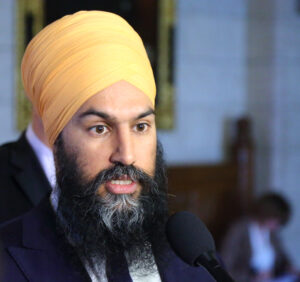Canada’s NDP: Preparing to Fight on All Fronts in Next Campaign
 Doubling down on progressive policies that tackle inequality, the recent NDP policy convention provided an opportunity for Leader Jagmeet Singh to deliver his core message of fighting for Canadians. It also saw Singh receive 87% support on his second leadership review, securing his leadership for the next federal election and surpassing his predecessor, Thomas Mulcair, who failed to capture the support of his party and had his leadership cut short.
Doubling down on progressive policies that tackle inequality, the recent NDP policy convention provided an opportunity for Leader Jagmeet Singh to deliver his core message of fighting for Canadians. It also saw Singh receive 87% support on his second leadership review, securing his leadership for the next federal election and surpassing his predecessor, Thomas Mulcair, who failed to capture the support of his party and had his leadership cut short.
Singh’s keynote address had a near-singular focus on the Liberals and their track record. Whereas, at the federal Liberal convention, Prime Minister Justin Trudeau’s focus was on Opposition Leader, Erin O’Toole. The NDP are contrasting themselves with the Liberals by focusing on “fighting for everyday Canadians struggling to make ends meet, instead of the wealthy and corporations.” Although there are distinct differences in policy approach, this language is not dissimilar to Conservative messaging. In reflecting on the government’s pandemic response, Singh highlighted the NDP’s fight to expand pandemic responses such as the wage subsidy and the CERB.
Preparing for a Looming Election
Looking ahead to the next campaign, Singh is positioning the NDP as the party that will fight to get results for Canadians: focusing on the ultra-rich and corporations paying their “fair share” of taxes, putting people first by implementing universal national pharmacare, ensuring public long-term care, tackling hate, racism, and discrimination, and combatting the climate crisis through investment in a sustainable recovery.
From a policy perspective, the party went into the convention with an ambitious short list of 140 policy resolutions (pared down from 500), and ultimately adopted 13 resolutions. Added to the party’s policy book are cancelling student debt, eliminating for-profit long-term care, a wealth tax on millionaires, implementing the 231 recommendations of the National Inquiry into Murdered and Missing Indigenous Women and Girls, and establishing a publicly owned telecom company to expand high-speed internet. The NDP also passed a controversial resolution that would suspend arms sales to Israel and place sanctions on Israeli settlements.
Challenging circumstances from convention floor to campaign trail
Virtual conventions are new and no one thinks they are easy to run. However, the convention’s less-than-smooth roll-out mirrors that of a Party facing some challenging internal workings. Technical issues and missing accessibility services led to insufficient time to debate and vote on policy resolutions. Backlash was swift, hitting both the convention floor and social media, with some members calling for the convention to be postponed.
Similarly, the NDP’s readiness to fight an election campaign has been fraught with challenges. The Party’s previous election debt, viewed to be a major hurdle to the next campaign, has been paid off, and up to $24 million is ready to be deployed for the next campaign. However, some members have questioned the NDP’s readiness for a digital campaign and adapting to the realities of a COVID-era campaign, such as mail-in ballots.
Fighting for more than just seats in the next campaign
The much larger question for the NDP is how they fight the next campaign and stay relevant. They are defending territory on all fronts in the election ahead. The main threat is from the Liberals on the progressive front. On the left, the NDP is attempting to shore up their environmental and climate change policies and prevent losses to the Greens, while on the right, they are fighting intrusion from the Conservatives on trade union votes.
At the same time, they will have to try to solve their Quebec problem, where the Bloc Québécois has re-established itself as a substantive presence on the political landscape and the NDP hold only one seat – that of Deputy Leader Alexandre Boulerice.
The next election will have high stakes for the NDP. Since 2019, their small, 24-member caucus consistently provided the Liberals with a slim balance of power, including through the COVID-19 pandemic response. Looking to the next campaign, the NDP are being squeezed on all sides. The success or failure of the NDP campaign can have significant electoral impact.
Traditionally, the Conservatives rely on the NDP to be strong enough in some key seats to split with progressive vote and lead to a Conservative win. The NDP’s strength or weakness can significantly change who gets elected. While the main electoral goal for the NDP is another minority government, neither the Liberals or Conservatives will be seeking that outcome – and a majority government, especially a majority Liberal government, could leave the NDP searching for relevance.